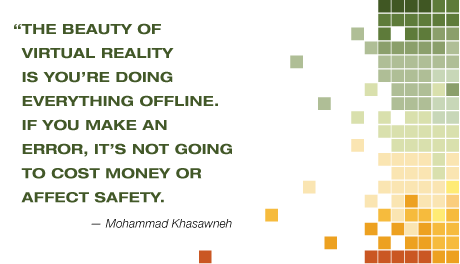page 1 | page 2

“A simulator should allow us to train very novice operators and bring them to the skill level of those who are experienced,” Khasawneh says. “For those who are more advanced, it should allow them to experience things they have not done for newly designed products.”
One of Khasawneh’s latest projects involves designing a training module for a microlithography machine recently acquired by the Center for Advanced Microelectronics Manufacturing (CAMM ) at Binghamton. The virtual-reality training could one day help ensure that employees of the CAMM ’s corporate partners arrive at the lab ready to use the equipment effectively.
“We’re dealing with very complex machines,” Khasawneh says. “With the roll-to-roll process and creating flexible displays, they use very expensive equipment, in the millions of dollars. So training becomes very important. My involvement will help lower the cost of operating some of these machines.”
He’s also working with the inventors of a large sphere-shaped virtual-reality system called the VirtuSphere to help explore its potential in improving human performance in a variety of applications, such as military and law-enforcement simulated training, education and learning systems, real estate and architecture virtual walk-throughs and rehabilitation.
“This technology employs the most natural form of navigation, overcoming the limitations of existing virtualreality systems,” Khasawneh said. “The VirtuSphere allows the person to walk, jump, roll, crawl, run and move in any direction for virtually unlimited distances.”
This advanced system, created by Russian brothers Nurakhmed and Nurulla Latypov, uses a wireless headset that senses the movements of virtual explorers, allowing life-like movements controlled with a joystick or keyboard.
Khasawneh, a native of Jordan whose research interests include human factors engineering in manufacturing and aviation systems, quality and simulation, joined Binghamton’s faculty in 2003. He has helped to establish a Human Factors and Ergonomics Research Laboratory at the University, aided in part by a recent software grant from UGS Corp. valued at $13.2 million. The company provided software from its Tecnomatix suite of products, which is used by firms around the world to improve the ergonomics of product design and workplace tasks.
Khasawneh sees such software and virtual-reality factories as an important industry trend. Soon companies won’t consider moving a machine, let alone building a new factory, without first testing it in the virtual world, he says.
Other virtual-reality applications range from virtual museum expansion projects to “exposure therapy” in which people are exposed to something they fear in a controlled way. The military is also using virtual reality to treat some veterans suffering from post-traumatic stress disorder.
“Our focus now,” Khasawneh says, “is proving to the rest of the world that virtual reality is going to be successful in electronics manufacturing and packaging.”
— Rachel Coker
page 1 | page 2